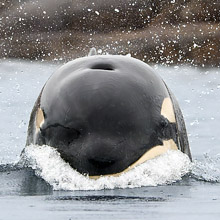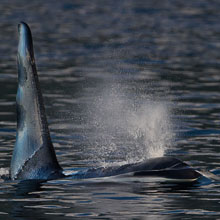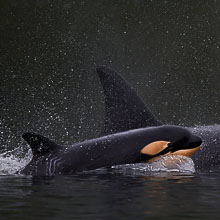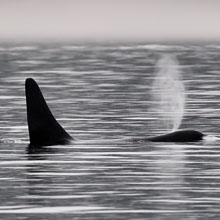Availability: Undetermined - Enquiries?
In the Field
Power & Beauty. Northern Vancouver Island, BC, Canada. August 24, 2010.
It's hard to describe the feeling experienced when a large male Killer Whale swims purposefully in your direction - even if you're safely ensconced on a boat. It's kind a mix of awe and a little fear - and certainly a respect for the power they simply exude. At the same time there's admiration for their beauty and grace, especially given their large size (the dorsal fin pictured here is about 2 meters - or 6 feet - tall).
I captured this image during a week-long photo trip in the late summer of 2010. While this is a pretty simple image, there's a few things I like about it - some are from a photographic perspective and some are from a biological perspective. The first thing is the timing of the capture (which was pure luck) - those "blows" expel water vapor at an amazing velocity and the odds of catching one just as it's beginning (and totally within the picture frame this when this close up) is low, low, low. Someone was smiling on me when I shot this. I also like (and this is another flukey thing) that the white underside of the whale is showing through despite being underwater. And, last but not least (and I DID see this when I shot the image, and focused on it) was the "standing wave" of water low on the dorsal fin. To me that adds visual interest to the shot and is just plain cool.
Before this trip I thought that Killer Whales were black and white, with perhaps a few grayish areas below their dorsal fin (their "saddles", which are used in identifying individuals). After all, every photo I've seen of them before - and certainly all illustrations I've seen in field guides - shows them as having only two "colours" - black and white (I know that technically black and white aren't single colours per se, but give me some latitude here!). But soon after I began this trip I noticed that parts of the body - most noticeably the dorsal fin - reflected various colours (most commonly a baby blue). Under bright sunlight the colours weren't visible, but when the sun went behind a cloud (like in this shot) the colours just popped. When I shot this image we had a mix of clouds and blue sky - which accounts for the blue reflections in the water. To me the most interesting thing to these coloured dorsal was that while the colour changed depending on the light, the positioning of it didn't. So, those two very dark patches on the trailing edge of the fin were ALWAYS dark - they were obviously a different colour and/or texture and reflected light differently than the lighter blue zones. By the way - the colours here are "natural" - I haven't selectively manipulated or saturated them.
Like most nature photographers I used to seek out direct sunlight (often in early morning or evening) to photograph wildlife. But, since converting to digital, and especially since the ISO performance of digital cameras has improved so much, I have found myself actively seeking overcast (and even rainy) conditions to photograph wildlife. This is especially true if I'm working "in tight" with my subject. The reason? This image illustrates it well - the colour (including tonal range and range of hues) is often SO much better when the lighting is more diffuse (and less harsh). Nowadays I tend to shun the light I used to seek! Funny how things change...
Here's a higher resolution (2400 pixel) version of this dramatic scene:
• Power & Beauty: Download 2400 pixel image (JPEG: 2.4 MB)
ADDITIONAL NOTES:
1. This image - in all resolutions - is protected by copyright. I'm fine with personal uses of it (including use as desktop backgrounds or screensavers on your own computer), but unauthorized commercial use of the image is prohibited by law. Thanks in advance for respecting my copyright!
2. Like all wildlife photographs on this website, this image was captured following the strict ethical guidelines described in The Wildlife FIRST! Principles of Photographer Conduct. I encourage all wildlife photographers to always put the welfare of their subjects above the value of their photographs.
3. This image was captured during my "Humpback, Orcas, Sea Lions & More" photo tour in August of 2010. Each year I offer trips into two different parts of the Great Bear Rainforest as well as one to photograph aquatic mammals and oceanscapes near the northern tip of Vancouver Island. And, in selected years, I also offer photo tours to locations to capture other highly sought-after subjects, such as various owl species of the boreal forest and wildlife of Canada's Arctic. Details about these trips can be found on the Photo Tours page of this website.
Behind the Camera
Power & Beauty. Northern Vancouver Island, BC, Canada. August 24, 2010.
Digital Capture; RAW 14-bit format; ISO 2500.
Nikon D3s with Nikkor 600mm f4 VRII lens hand-held and shot from sailboat. VR on and set to "Normal" mode. Circular polarizer used.
1/1250s @ f5.6; -0.67 stop compensation from matrix-metered exposure setting.
At the Computer
Power & Beauty. Northern Vancouver Island, BC, Canada. August 24, 2010.
RAW Conversion to 16-bit TIFF, including first-pass/capture sharpening and slight noise using Phase One's Capture One Pro 5. Two raw conversions: one at -1.0 stops to retrieve highlight detail in water spray of blow; remainder of image at +0.25 stops.
Further digital corrections on 16-bit TIFF file using Adobe's Photoshop CS5 and Light Craft's LightZone. Photoshop adjustments included compositing and masking of two source files, and selective sharpening for web output. Final tonemapping and contrast/tone tweaking performed with LightZone using the tonemapper/re-light tool.
Conservation
Power & Beauty. Northern Vancouver Island, BC, Canada. August 24, 2010.
Ten percent of the revenue generated by this image will be donated to Raincoast.
Species Status in Canada*: Endangered - Northeast Pacific southern resident population; Threatened - Northeast Pacific transient population and the Northeast Pacific northern resident population; Special Concern - Northeast Pacific offshore population.
Killer Whales (Orcinus orca) have an extremely high profile in modern pop culture and have become the "poster child" of a number of conservation groups. In most areas where Killer Whales are found they show a remarkable ability to adapt to a variety of habitats - they are found in all oceans, in water ranging in temperature from below 0 Celsius to almost hot tropical waters, and will occasionally even spend significant amounts of time in brackish water or even rivers.
Because the population sizes of Killer Whales are very low and because they have a very low reproductive rate, they face immediate risk from human-related environmental disturbances, including the immunotoxic effects of toxic chemicals we pour into the oceans and to reduction in prey availability (such as salmon).
This adult male Killer Whales was photographed near the northern tip of Vancouver Island. The Raincoast Conservation Society is fighting to protect the Great Bear Rainforest along the central and northern coast of British Columbia. This unique ecosystem harbours a strong population of many high-profile species such as Brown Bears and Gray wolves, plus many species that serve as prey for the Killer Whale. If you are looking for a meaningful way to contribute to the conservation of the Great Bear Rainforest and all its associated species, Raincoast will provide maximal "bang" for your conservation dollars.
For more information on the status of Killer Whales in Canada, go to: http://www.speciesatrisk.gc.ca and search under "Killer Whale".
*as determined by COSEWIC: The Committee on the Status of Endangered Wildlife in Canada

























